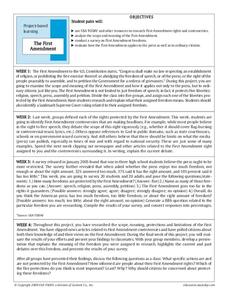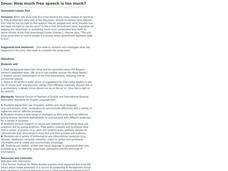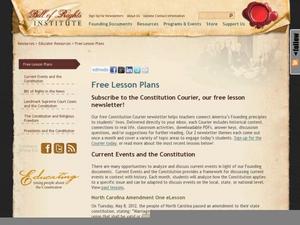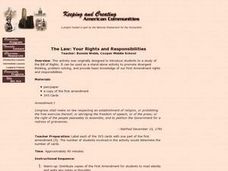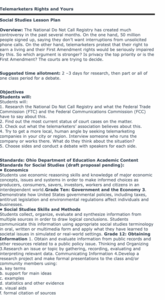Curated OER
The First Amendment: What's Fair in a Free Country
Students describe the contents of the First Amendment while telling about an example of speech that is protected by the Constitution and that which is not. They attempt to apply the First Amendment to situations that could occur in their...
Curated OER
Protesting within First Amendment Rights
Learners research the First Amendment and what it says about the right to peaceably assemble as well as read in particular about those who were arrested or removed from an area for being disruptive during a protest on the War in Iraq....
Curated OER
The First (and Last) Words
What does "freedom of speech" mean to your class, especially in the context of Internet communications? In round-table discussion format, middle and high schoolers address the issues discussed in "State Legislatures Across U.S. Plan to...
Curated OER
Pornography Debate
Present your seniors with a controversial topic while studying the first amendment: pornography. This multi-layer resource has scholars writing a pros and cons research paper. They also attend a city council meeting to prepare for an...
Heritage Foundation
Substantive Amendments: Amendments I and II
The First and Second Amendments remain some of the most famous, even to this day. Learners read about several clauses from the US Constitution through a variety of captivating activities including before and after reading, group work,...
Curated OER
The First Amendment
Eleventh graders examine the First Amendment. In this US Government lesson plan, 11th graders analyze the scope and meaning of the first amendment. Students conduct a survey on First Amendment freedoms. Student evaluate...
Curated OER
The Bill of Rights: Debating the Amendments
Provide your class with an opportunity to investigate an important historical document. Without identifying the document, distribute copies of the original Bill of Rights, as transcribed by John Beckley, Clerk of the House of...
Curated OER
Imus: How much free speech is too much?
Students explore current interpretation of the First Amendment, including that of commercial speech. Next read background about Don Imus and his comments about the Rutgers women's basketball team.
Curated OER
How do we know if it’s a First Amendment Issue?
Students consider First Amendment rights. In this Bill of Rights activity, students complete an activity guide regarding plans to build an Islamic cultural center near Ground Zero in New York City. Students respond to discussion...
National Woman's History Museum
The Equal Rights Amendment
The debate over the Equal Rights Amendment continues. To better understand the controversy, class members research the history of attempts to get the amendment ratified. In addition, pairs engage in a structured academic conversation...
Curated OER
Constitutional Amendments and Gay Marriage
High schoolers study the legal battles involving same-sex marriage. They examine primary sources and a video regarding the 14th amendment and its implications for gay marriage. They analyze a report of a California case that was sent to...
C-SPAN
The Impact of Citizens United v. FEC
What began as an effort to show a movie by an interest group has impacted financing of federal elections. Did the Citizens United case lead to more "dark money" in politics, or did it shine a light with more speech? Using video clips...
Heritage Foundation
The Amendment Process and the Bill of Rights
Did you know that lawmakers have proposed more than 5,000 bills to amend the US Constitution in Congress? Your class learns intriguing facts about the process of choosing amendments. A variety of activities including before and after...
Curated OER
Freedom of Hate Speech?
Learners, using a New York Times article as a springboard for discussion, investigate and debate the complex issues of First Amendments Rights and censorship for Hate Groups using Websites for propaganda.
The New York Times
Where to Draw the Line: Balancing Government Surveillance with the Fourth Amendment
The question of how to balance Fourth Amendment Rights with national security concerns becomes critical in an age of planned terrorist attacks, election interference, and fake news. Get young social scientists involved in the debate with...
Curated OER
The Law: Your Rights and Responsibilities
Students explore First Amendment rights and responsibilities.
K20 LEARN
Show Me Your Credentials: Voting In America
The debate over voting rights continues. To begin their study of voting rights, class members first vote on proposed new classroom rules. After a discussion of the activity, groups are given a copy of the 1965 Alabama Literacy Test and...
National Endowment for the Humanities
James Madison: Raising an Army—Balancing the States and the Federal Government
To war! To war! Every nation in the history of the world has had to deal with warfare on some level. Scholars go through a series of activities and discussions surrounding the development of the Constitution to help them better...
Newseum
You Can’t Say That: Right to Know vs. Security Risk
Print or block? That is the question young journalists debate as part of their study of the freedom of the press. Half the class represents the journalists' legal team, and the other half represents the government's legal team. Teams...
Center for Civic Education
The Equal Rights Amendment in the 1970s and Today
Discover the fascinating history of the Equal Rights Amendment and discuss the major implications and considerations associated with it today. Here you will find background information on the topic, a graphic organizer summarizing...
Curated OER
Church and State Separation: The Challenge and the Debate
Students describe the basic elements of the U.S. Constitution's First Amendment as it relates to the separation of church and state and freedom of religion.
Curated OER
The Bill of Rights: Debating the Amendments
Students interpret historical evidence presented in primary and secondary resources. In this Bill of Rights lesson plan, students research 12 possible amendments that were considered for the Constitution in 1789....
National First Ladies' Library
How a Bill Becomes a Law
High schoolers engage in the democratic process and to learn how a bill become a law. Then they write a bill they would like as law in their classroom. Students also form committees that will review the list of bills to determine if they...
Curated OER
Telemarketers Rights and Yours
Pupils research the controversy of whether or not the National Do Not Call Registry is constitutional, and then hold a class debate. Students research the National Do Not Call Registry, the FTC, the FCC, and the most current status of...







